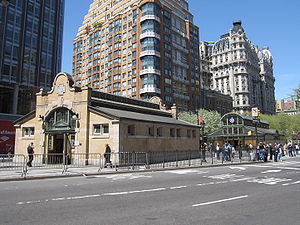- 72nd Street (IRT Broadway
-
72nd Street



New York City Subway rapid transit station
Original Control house (left) and newer Control house, located on opposite sides of 72nd StreetStation statistics Address area of West 72nd Street, Broadway & Amsterdam Avenue
New York, NY 10023Borough Manhattan Locale Upper West Side Coordinates 40°46′44″N 73°58′55″W / 40.779°N 73.982°WCoordinates: 40°46′44″N 73°58′55″W / 40.779°N 73.982°W Division A (IRT) Line IRT Broadway – Seventh Avenue Line Services 1  (all times)
(all times)
2 (all times)
(all times)
3 (all times)
(all times)Connection - New York City Bus: M5, M7, M11, M57, M72, M104
Structure Underground Platforms 2 island platforms
cross-platform interchangeTracks 4 Other information Opened October 27, 1904[1] Accessible 
Traffic Passengers (2010) 12.137 million[2][3]  1.8%
1.8%Rank 20 out of 422 Station succession Next north 79th Street (local): 1  2
2 
96th Street (express): 2 3
3 
Next south 66th Street – Lincoln Center (local): 1  2
2 
Times Square – 42nd Street (express): 2 3
3 
Next  north
north96th Street: 1  2
2  3
3 
Next  south
south66th Street – Lincoln Center (local): 1
 2
2 
Times Square – 42nd Street (express): 2 3
3  Control House on 72nd Street
Control House on 72nd StreetMPS: Interborough Rapid Transit Subway Control Houses TR NRHP Reference#: 80002684[4] Added to NRHP: May 6, 1980 72nd Street (IRT Broadway – Seventh Avenue Line)MPS: New York City Subway System MPS NRHP Reference#: 04001017[4] Added to NRHP: September 17, 2004 Station service legend Symbol Description 
Stops in station at all times 
Stops all times except late nights 
Stops late nights only 
Stops late nights and weekends only 
Stops weekdays only 
Stops all times except rush hours in the peak direction 
Stops all times except weekdays 
Stops rush hours only 
Stops rush hours in the peak direction only 
Station is closed (Details about time periods) 72nd Street is an express station on the IRT Broadway – Seventh Avenue Line of the New York City Subway, located at the intersection of Broadway, 72nd Street and Amsterdam Avenue (including Verdi Square and Sherman Square) on the Upper West Side of Manhattan. It is served by the 1, 2 and 3 trains at all times.
This underground station, opened on October 27, 1904 as part of the original subway, has two offset island platforms and four tracks. The 1 and 3 trains stop at the local and express tracks, respectively, at all times. 2 trains stop at the express tracks at all times except late nights, when they stop at the local ones. The platforms have a line of red, mostly round, columns. A decorative trimline of brown greens and reds and tiled carpets run along the local track walls.
The original configuration of the station was inadequate by IRT standards. It had just one entrance (the Control house on the traffic island between 71st and 72nd Streets, now listed on the National Register of Historic Places) and the platforms and stairways were unusually narrow. There were no crossovers or crossunders as the control house had separate turnstile banks and token booths for each side.
A substantial renovation was completed on October 29, 2002, providing a new, larger control house on the traffic island between 72nd and 73rd Streets and slightly wider platforms at the north end of the station. This control house has two staircases and one elevator from each platform going up to a crossover, where on either side a turnstile bank leads to either 72nd or 73rd Streets. Only the southern turnstile bank has a staffed token booth and the elevators make this station ADA-accessible.[5]. This control house has an artwork called Laced Canopy by Robert Hickman. It consists of a mosaic pattern on the central skylight.
The original control house was renovated and now has three staircases from each platform go up to a crossover, where on the north side, an unstaffed turnstile bank leads to 72nd Street and on the south side, three High Entry/Exit Turnstiles lead to 71st Street. This control house has artful wrought iron pillars and decorated ceiling beams.
During the 1950s, the New York City Transit Authority (now MTA) considered converting the station to a local station by walling off the express tracks from the platforms. This would have coincided with 59th Street – Columbus Circle, which is a major transfer point to the IND Eighth Avenue Line, becoming an express stop.
Image gallery
-
Detail of the wall decoration with a fleur-de-lis
References
- ^ New York Times, Our Subway Open: 150,000 Try It, October 28, 1904
- ^ "Facts and Figures: 2010 Annual Subway Ridership". New York City Metropolitan Transportation Authority. http://mta.info/nyct/facts/ridership/ridership_sub_annual.htm. Retrieved 2011-05-18.
- ^ "Facts and Figures: 2009 Subway Ridership". New York Metropolitan Transportation Authority. Archived from the original on 2011-02-08. http://www.webcitation.org/query?id=1297218419587350. Retrieved 2010-04-07.
- ^ a b "NPS Focus". National Register of Historic Places. National Park Service. http://nrhp.focus.nps.gov. Retrieved November 6, 2011.
- ^ "New Headhouse Opens at West 72nd Street" (Press release). Metropolitan Transportation Authority. 2002-10-29. http://mta.info/mta/news/releases/?en=021029. Retrieved 2010-02-21.
External links
- nycsubway.org — IRT West Side Line: 72nd Street
- nycsubway.org — Verdi's Rigoletto Artwork by Robert Hickman (2005)
- Station Reporter — 1 Train
- Station Reporter — 2 Train
- Station Reporter — 3 Train
- 72nd Street at The Subway Nut - [1]
- Forgotten NY — Original 28 - NYC's First 28 Subway Stations
- MTA's Arts For Transit — 72nd Street (IRT Broadway – Seventh Avenue Line)
- newer headhouse at 72nd Street from Google Maps Street View
- older headhouse at 72nd Street from Google Maps Street View
Categories:- IRT Broadway – Seventh Avenue Line stations
- Railway and subway stations on the National Register of Historic Places in Manhattan
- New York City Subway stations in Manhattan
- Railway stations opened in 1904
- Heins and LaFarge buildings
Wikimedia Foundation. 2010.









